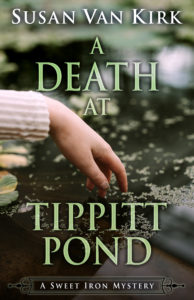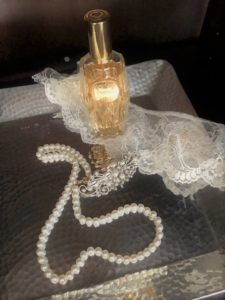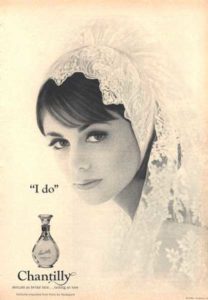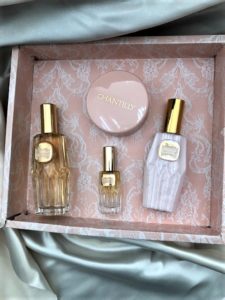 When I was growing up, my parents rented a room to a lady who was working at a store in our town. It was shortly after the end of World War II. Her name was Margaret, and she came from a tiny rural town twenty miles away. I imagine our city had more opportunities to work compared to jobs in hers. We called her “Aunt Margaret,” and eventually she moved back to her home when I was still in elementary school. My family went to visit her and her two sisters, and the one memory I have from those visits is the smell of sugar cookies in their kitchen. Even now, that smell can take me back to that small town, that kitchen with the linoleum floors and tea towels hanging from the bar on the sink, and “Aunt Margaret,” who has since passed away.
When I was growing up, my parents rented a room to a lady who was working at a store in our town. It was shortly after the end of World War II. Her name was Margaret, and she came from a tiny rural town twenty miles away. I imagine our city had more opportunities to work compared to jobs in hers. We called her “Aunt Margaret,” and eventually she moved back to her home when I was still in elementary school. My family went to visit her and her two sisters, and the one memory I have from those visits is the smell of sugar cookies in their kitchen. Even now, that smell can take me back to that small town, that kitchen with the linoleum floors and tea towels hanging from the bar on the sink, and “Aunt Margaret,” who has since passed away.
Although many memories of my early years have disappeared, I remember clearly the smell of those cookies. That connection between smell and memory led me to a perfume that plays many roles in my upcoming book, A Death at Tippitt Pond.
Olfaction
First, however, I wondered why olfaction—or our sense of smell—is clearly connected to memory.
To use a layman’s explanation, I’ll simply say that the first processing of smell inside the nose connects directly to two parts of the brain that are strongly associated with emotions and memories: the amygdala and hippocampus. Smells pass a lot of other areas of the brain but utilize particularly these two. Studies show smell triggers memories more clearly than visual images because of how the information from this sense is processed in our brains. No wonder the perfume industry sells their products with this concept.
What does this have to do with my mystery, A Death at Tippitt Pond?
Creating the Past
Beth Russell, my protagonist, lives in the present day, but her life becomes connected to people who existed in the 1960s and 1970s. What a fantastic era of excess and craziness! I had so much fun creating some of the artifacts of that time, especially since I’d lived in that period.
I think of this as “past history,” but to me, it doesn’t seem that long ago.
I researched clothes, music, books, and historical events. After all those research areas, I focused on a smell. That’s right. A  smell. In my teenage years, the popular perfume was called “Chantilly.” Packaged in a pink box, it was the rage of our preteen and teenage years. Guaranteed to find you a man because of its haunting and sensual fragrance, Chantilly was the perfect symbol of my fictional Melanie Tippitt, who wore it during her teenage years. Anyone growing up in the 1950s and 1960s remembers this perfume.
smell. In my teenage years, the popular perfume was called “Chantilly.” Packaged in a pink box, it was the rage of our preteen and teenage years. Guaranteed to find you a man because of its haunting and sensual fragrance, Chantilly was the perfect symbol of my fictional Melanie Tippitt, who wore it during her teenage years. Anyone growing up in the 1950s and 1960s remembers this perfume.
Back then, despite the women’s revolution, small town girls in the middle of the country were still tuned in to finding a man and raising a family. Chantilly was the scent of preference, worn by my friends and me. The perfume-maker connected it to love and marriage in their ads at that time. You can see that in this vintage ad from 1964.
A Brief History of Chantilly
I didn’t realize this perfume was first made in 1941 and produced by the French perfume company, Houbigant. During the war, women who worked in the factories wore Chantilly during their evenings because it made them feel more feminine. Its marketing was all about being romantic and sensual, like the French lace it was named for. That lace was used in the wedding veils of royal brides.
 In the early 1990s, Houbigant filed for bankruptcy, and Dana Perfumes acquired Chantilly in 1999. It is still marketed in pink boxes, bringing back memories for baby boomers like me. Recently, I bought a set of cologne, power, and lotion just to check out the scent. Yes, I remembered it.
In the early 1990s, Houbigant filed for bankruptcy, and Dana Perfumes acquired Chantilly in 1999. It is still marketed in pink boxes, bringing back memories for baby boomers like me. Recently, I bought a set of cologne, power, and lotion just to check out the scent. Yes, I remembered it.
Chantilly and A Death at Tippitt Pond
Chantilly’s first appearance in my upcoming mystery is a haunting description of Beth’s reaction when she first smells its fragrance.
“She sprayed a little of the perfume into the air. The fragrance was strong and powdery, with a scent of orange blossoms and lemon. Maybe a hint of vanilla too, Beth mused. She closed her eyes, taking in the aroma. Over her came a softness, a tenderness, a comfort as if she never need worry about anything ever again. Her whole body relaxed. It was hard to describe: a feeling of euphoria, lightness, peace. Joy spread through her, and her breathing slowed down. It was a sense of being held in someone’s arms—safe, cared for, and loved.”
Sound a little spooky? Why is this memory important, and what does it represent in Beth Russell’s life? You’ll find the answers to those questions this summer. If you lived during the 1960s and 1970s, this upcoming mystery will be a trip down memory lane … except for a murder or two.
(A Death at Tippitt Pond will be available June 15, 2019, from Encircle Publications. And, of course, I’ll bring some Chantilly to book signings!)

Chantilly was my mom’s favorite perfume.
I have a feeling she would have had plenty of company with that scent!!
I didn’t wear perfume until college and Chantilly was “too girly” for me. I wore Ambush or Tabu.
Yes, those were out there also, as well as White Shoulders. Chantilly was a bit “girly” and had a flowery smell. Whoa, Mary! Ambush and Tabu? I learn new things every day!
I can hardly wait to read it! My favorite cologne of the era was Shalimar. I worked as a “curbie” at the Grandview Drive-In when I was in high school and saved up enough tips to buy a bottle at O.T. Johnson’s. I treasured it. The model in the picture looks like the gorgeous Jean Shrimpton who was the most beautiful English girl of the era. My sister and I collect vintage fashion magazines of the era which have all these wonderful ads.
Oh, that’s so funny. Those were the days when we had to save our money to buy something special. Love to look at those vintage pictures of fashion. Twiggy, miniskirts, and the latest wild clothes from Britain.
Thanks for the memories, Susan. I can’t wait to read this book, either. You made me think, too, of The Big Bopper and his song, “Chantilly Lace.” When you mentioned “Dana” I immediately thought of Ambush and Tabu (I preferred the first) and if a boy had Canoe, one of Dana’s male scents, I was immediately in love. I had Chantilly too, of course, but it was ruined forever for me when my bottle slipped off a shelf and broke on a radiator. You can imagine…
Thank you for visiting my blog, Tricia. Every time I wrote “chantilly” I thought about those lines from the Big Bopper. Isn’t it amazing how we remember those scents? Even their names are in our memories—such promises of adventure, romance, and intrigue. Sorry you also have the radiator memory. I did a similar thing with a Roy Orbison record. At least that smell left me quickly.
I loved Chantilly for its beautiful powdery scent and its feminine appeal. Oh how much I wish I could find it smelling like it did when made by Houbigant.
I would buy it. I keep searching for a scent like it, but none compare.
I agree with you, Laura. There was nothing like it. I guess that means it stays locked in memory, but what a pleasant memory.
Interesting post, Susan. The scent lodged firmly in my memory is Muguet des Bois, aka Lily of the Valley. Still my favourite flower, but I’m no longer dabbing perfume behind my ears.
My other fave at that time was Yardley’s Oh! de London. Why yes, it was 1968.
Ah, even more wonderful memories. I remember those too. Probably advertised in Seventeen magazine or Teen magazine, both arriving monthly in my mailbox to be pored over religiously. 1968–what an amazing year that was!
I still have some of it from a while back. The smell always kind of reminds me of baby powder. I still like the smell.
Why does it not surprise me that a poet would have Chantilly perfume? I’m smiling. Seems so like you!
Chantilly formula has changed! it now smells awful . Gone is the l wonderful scent that we all loved so well. Called Dana and they seem nit to care . The response is sometimes we can not get the same ingredients.
too bad I was such a loyal customer . beware if you buy . Light peach color now as well as really bad smell.